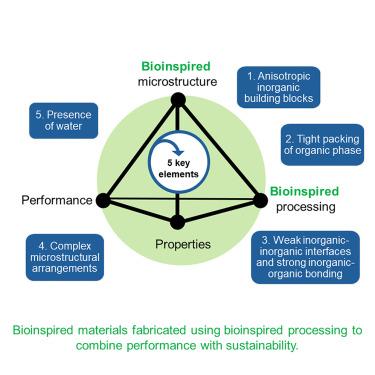可持续制造高性能生物启发陶瓷增强聚合物复合材料的生物启发加工技术
IF 17.3
1区 材料科学
Q1 MATERIALS SCIENCE, MULTIDISCIPLINARY
引用次数: 0
摘要
虽然具有出色机械性能的生物启发材料已经研发成功,但目前的制造方法耗能且依赖于苛刻的条件。相反,天然陶瓷复合材料在环境温度和压力下生长,表现出的高性能可能并不适合工程应用。基于高度矿化的生物陶瓷复合材料,确定了五个关键的结构元素:(1) 各向异性的无机构件,(2) 有机相的紧密堆积,(3) 弱的无机-无机界面但强的无机-有机结合,(4) 复杂的微结构排列,以及 (5) 水的存在。虽然每种既定元素都有一种生物启发策略,但一些三维打印方法似乎有望将所有元素结合到一个过程中。鉴于未来的应用,更好地评估生物启发陶瓷复合材料的可持续性及其市场化也至关重要。本综述旨在向研究人员介绍利用生物启发开发先进陶瓷复合材料可持续工艺的方法。本文章由计算机程序翻译,如有差异,请以英文原文为准。


Bioinspired processing for the sustainable fabrication of high-performance bioinspired ceramic-reinforced polymer composites
Although bioinspired materials with outstanding mechanical properties have been developed successfully, current manufacturing methods are energy consuming and rely on harsh conditions. On the contrary, natural ceramic composites are grown at ambient temperature and pressure, exhibiting high performance that may not be suitable for engineering applications. Based on highly mineralized biological ceramic composites, five key structural elements were identified: (1) anisotropic inorganic building blocks, (2) tight packing of the organic phase, (3) weak inorganic-inorganic interfaces but strong inorganic-organic bonding, (4) complex microstructural arrangements, and (5) presence of water. While there is a bioinspired strategy for each established element, some 3D printing methods appear promising in combining all into a single process. A better assessment on the sustainability of bioinspired ceramic composites and their marketization is also critical in view of future applications. This review serves to inform researchers on approaches to develop sustainable processes for advanced ceramic composites using bioinspiration.
求助全文
通过发布文献求助,成功后即可免费获取论文全文。
去求助
来源期刊

Matter
MATERIALS SCIENCE, MULTIDISCIPLINARY-
CiteScore
26.30
自引率
2.60%
发文量
367
期刊介绍:
Matter, a monthly journal affiliated with Cell, spans the broad field of materials science from nano to macro levels,covering fundamentals to applications. Embracing groundbreaking technologies,it includes full-length research articles,reviews, perspectives,previews, opinions, personnel stories, and general editorial content.
Matter aims to be the primary resource for researchers in academia and industry, inspiring the next generation of materials scientists.
 求助内容:
求助内容: 应助结果提醒方式:
应助结果提醒方式:


